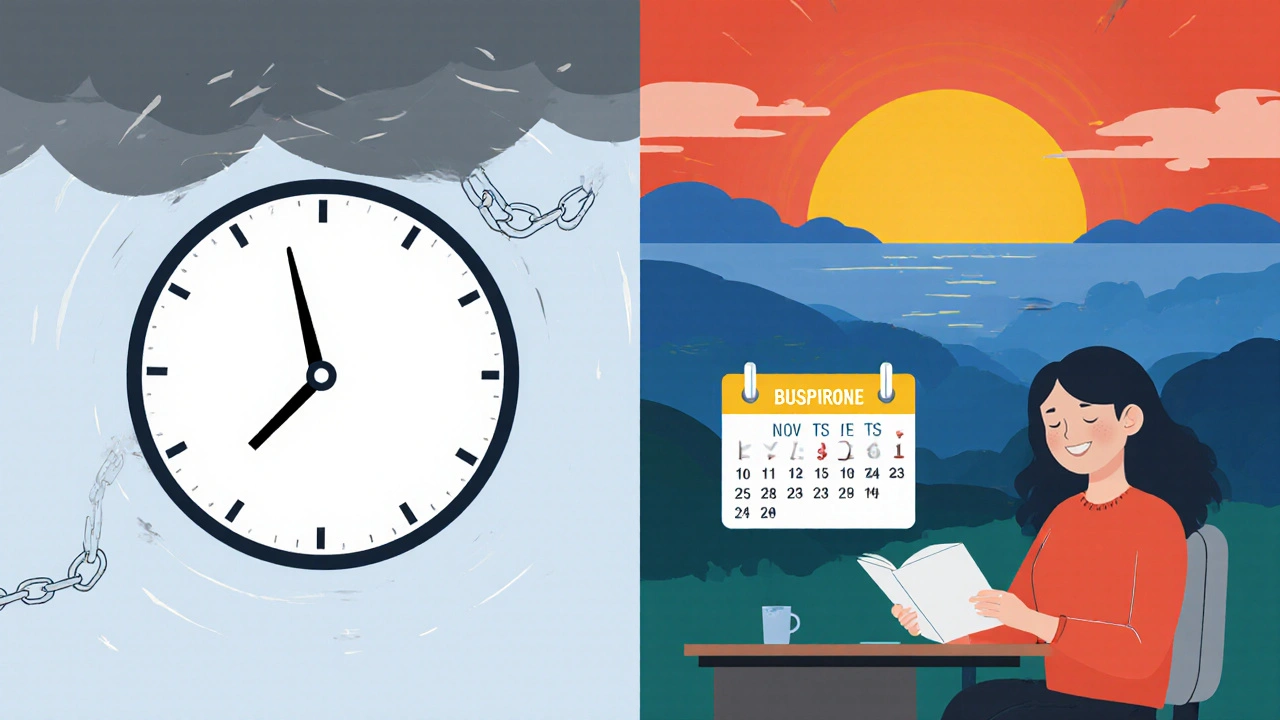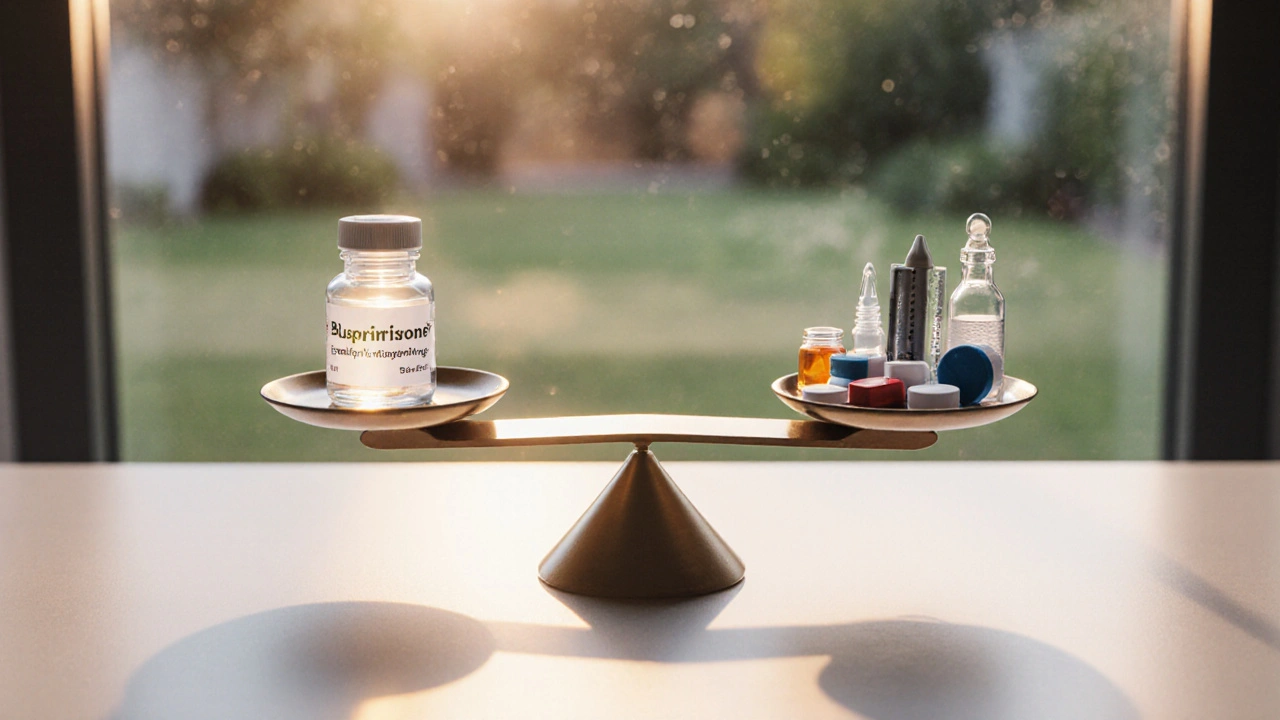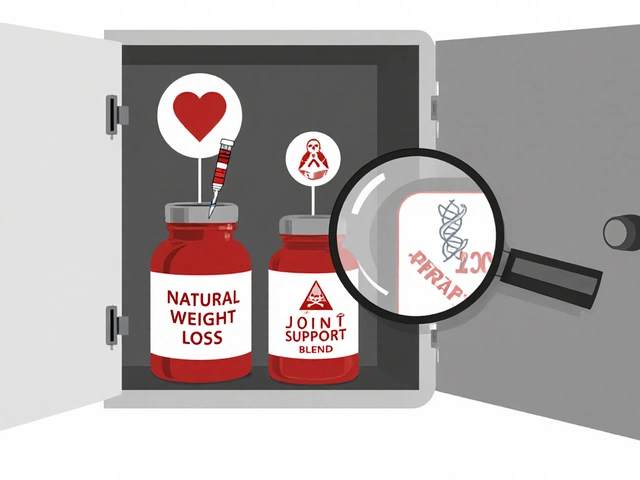Anxiety Medication Comparison Tool
Key Strengths
- Buspirone: Low risk of dependence, no sedation
- Benzodiazepines: Fast-acting for acute episodes
- SSRIs/SNRIs: Effective for chronic conditions
- Hydroxyzine: Quick relief with mild drowsiness
- Propranolol: Blocks physical symptoms without mood impact
Important Considerations
- Start with a healthcare provider
- Consider onset times and duration
- Review potential drug interactions
- Monitor for side effects
- Be aware of dependence risks
Feeling jittery, on edge, or stuck in a loop of worry? One of the first names that pops up is Buspirone - sold as Buspar - a prescription pill that’s been used for anxiety since the 1980s. But is it really the best fit for you, or do other options work better? This guide lines up Buspirone against the most common alternatives, points out where each shines or falls short, and gives practical tips for deciding what to try next.
Quick Take
- Buspirone works slowly, has low sedation and no addiction risk.
- Benzodiazepines (e.g., Alprazolam) act fast but can cause dependence.
- SSRIs/SNRIs (e.g., Sertraline, Venlafaxine) are best for chronic anxiety but need weeks to kick in.
- Antihistamine Hydroxyzine offers short‑term relief with mild drowsiness.
- Beta‑blocker Propranolol helps performance‑related anxiety without affecting mood.
What Is Buspirone?
Buspirone is a serotonin‑1A (5‑HT1A) receptor partial agonist. It reduces the brain’s response to stress without hitting the GABA pathway that benzodiazepines use. Typical adult dosing starts at 5mg twice a day, rising to 20-30mg split across three doses if needed.
Key traits:
- Onset: 2-3weeks for full effect.
- Side‑effects: light dizziness, headache, occasional nausea.
- Addiction: negligible - no known withdrawal syndrome.
- Drug interactions: caution with MAO‑inhibitors, certain antibiotics (e.g., erythromycin).
Major Alternatives at a Glance
| Medication | Class | Typical Use‑Case | Onset | Dependence Risk | Common Side‑Effects |
|---|---|---|---|---|---|
| Buspirone | Anxiolytic (5‑HT1A agonist) | Generalized Anxiety Disorder (GAD) - long‑term control | 2‑3weeks | None | Dizziness, headache, nausea |
| Alprazolam | Benzodiazepine | Panic attacks, acute anxiety spikes | 30minutes | High - tolerance & withdrawal | Sedation, memory issues, respiratory depression |
| Sertraline | SSRI | Chronic anxiety, depression overlap | 4‑6weeks | None | GI upset, sexual dysfunction, insomnia |
| Venlafaxine | SNRI | GAD & panic, especially when SSRIs fall short | 2‑4weeks | None | Elevated blood pressure, nausea, dizziness |
| Hydroxyzine | Antihistamine (sedating) | Short‑term anxiety relief, pre‑procedure calming | 15‑30minutes | None | Sleepiness, dry mouth, blurred vision |
| Propranolol | Beta‑blocker | Performance anxiety, situational tremor | 1‑2hours | None | Fatigue, cold hands, lower blood pressure |
| Gabapentin | Anticonvulsant (off‑label) | Anxiety with neuropathic pain, restless leg | 1‑2weeks | Low | Drowsiness, weight gain, edema |

How Buspirone Stacks Up Against the Rest
When you line up the pros and cons, a clear picture forms. Buspirone’s biggest win is its safety profile - no sedation, no hang‑over, and virtually no abuse potential. That makes it a go‑to for people who need to stay sharp at work or drive after a dose.
On the downside, the slow onset can be frustrating if you’re in the middle of a panic episode. That’s where a fast‑acting benzodiazepine like Alprazolam shines, but you’ll pay in tolerance and possible dependence.
SSRIs such as Sertraline and SNRIs like Venlafaxine provide robust, long‑term relief for both anxiety and co‑existing depression. Their catch? The wait time (weeks) and sexual side‑effects that can be a deal‑breaker for many.
If you need something short‑lived - say, before a public speech - Hydroxyzine or Propranolol can be ideal. Hydroxyzine offers calming without a “high,” while propranolol eases the physical tremor without changing mood.
For patients who also battle nerve pain, Gabapentin may kill two birds with one pill, but it can make you feel foggy.
Choosing the Right Drug for Your Situation
- Is your anxiety chronic or situational? Chronic GAD often benefits from Buspirone or an SSRI. Situational spikes (stage fright, exams) might be better served by Hydroxyzine or Propranolol.
- Do you need rapid relief? Benzodiazepines give the fastest answer but should be limited to short courses.
- Are you concerned about dependence? Skip benzodiazepines if that’s a red flag; Buspirone, SSRIs, and non‑sedating antihistamines have negligible risk.
- Any co‑existing conditions? High blood pressure makes Propranolol risky; liver disease can affect SSRI metabolism; asthma may limit certain beta‑blockers.
- Budget and insurance coverage? Generic versions of Buspirone, Sertraline, and Alprazolam are usually affordable; newer agents like Venlafaxine may cost more.
Talk to your prescriber about where you fall on these checkpoints. The best plan often blends two meds - for example, a low‑dose SSRI for baseline anxiety plus occasional Hydroxyzine for a big presentation.
Switching Safely Between Medications
Never stop a drug cold, especially benzodiazepines. A typical taper for Alprazolam might look like dropping 0.5mg every 3‑4days while introducing Buspirone at 5mg BID. SSRIs often need a 1‑week overlap because abrupt switches can trigger serotonin discontinuation syndrome (headache, electric‑shock sensations).
Keep a symptom diary: note anxiety levels, sleep quality, side‑effects, and any withdrawal signs. Share this log with your clinician - it speeds up adjustments and reduces trial‑and‑error.
Key Takeaways Checklist
- Buspirone = low risk, slow onset.
- Benzodiazepines = fast, high dependence.
- SSRIs/SNRIs = best for long‑term, possible sexual side‑effects.
- Hydroxyzine = short‑term, mild drowsiness.
- Propranolol = blocks physical symptoms, not mood.

Frequently Asked Questions
Can I take Buspirone with alcohol?
Mixing alcohol with Buspirone isn’t advised. While Buspirone isn’t sedating, alcohol can heighten dizziness and nausea, making you feel worse. If you do drink, keep it light and discuss it with your doctor.
How long does it take for Buspirone to start working?
Most people notice a modest drop in anxiety after about 1‑2weeks, but the full therapeutic effect often appears after 3‑4weeks of consistent dosing.
Is Buspirone safe during pregnancy?
Studies are limited, and the drug is categorized as Pregnancy Category B in the US, meaning animal studies haven’t shown risk but human data are insufficient. Your obstetrician will weigh benefits against potential unknowns.
Can I use Buspirone for panic attacks?
Buspirone helps with generalized anxiety but isn’t ideal for sudden panic attacks because it takes weeks to build up. Short‑acting benzodiazepines or fast‑acting antihistamines are usually preferred for acute panic.
What are the most common side‑effects of Buspirone?
The usual culprits are mild dizziness, headache, nausea, and occasional restlessness. Most side‑effects fade after the first two weeks.






15 Comments
One must appreciate the nuanced pharmacodynamic profile of Buspirone, particularly its 5‑HT1A partial agonism, which distinguishes it from the GABAergic mechanisms of benzodiazepines. The absence of sedative properties renders it an elegant choice for professionals who cannot afford cognitive blunting. Moreover, its negligible dependence potential aligns with a modern, risk‑averse therapeutic philosophy. While the delayed onset may irk those seeking immediate relief, the trade‑off is a sustainable anxiolytic effect without tolerance. In short, Buspirone exemplifies a sophisticated balance between efficacy and safety.
The comparison chart neatly outlines how each class targets different facets of anxiety, which is vital for shared decision‑making. It’s heartening to see the emphasis on slow titration and monitoring, as abrupt changes often jeopardize therapeutic gains. For individuals juggling work and family, the low‑sedation profile of Buspirone can be a subtle yet profound advantage. Equally, the rapid‑acting nature of alprazolam serves a purpose when acute spikes threaten safety. Ultimately, the clinician’s role is to tailor the regimen to the patient’s lifestyle, comorbidities, and personal preferences.
Buspirone’s low dependence is a solid win.
From a neuropharmacological standpoint, the key differentiator lies in serotonergic modulation versus GABAergic inhibition, which translates to divergent side‑effect spectra. Buspirone’s antagonism of dopamine D2 receptors is minimal, thereby preserving motivational drive, whereas benzodiazepines can precipitate amnestic deficits through hippocampal synaptic plasticity suppression. The pharmacokinetic half‑life of Buspirone also circumvents accumulation, reducing the risk of dose‑dependent dizziness. Clinicians should also note cytochrome P450 interactions, especially with CYP3A4 inhibitors, which can elevate plasma concentrations. In practice, these mechanistic insights inform both efficacy expectations and safety monitoring protocols.
It is noteworthy that the onset of Buspirone (2–3 weeks) aligns with the natural course of neuroadaptive changes required for serotonergic agents. The side‑effect profile, limited to mild dizziness and headache, is statistically lower than the sedation seen with antihistamines. When prescribing, consider patient adherence; the thrice‑daily dosing may challenge some individuals. Nonetheless, the absence of withdrawal phenomena distinguishes it from high‑risk benzodiazepines.
Oh great, another "safe" pill that takes weeks to work – because who doesn’t have the luxury of waiting months for calm? Sure, avoid the “danger” of dependence and miss out on actually feeling better now. Sounds like the perfect solution for those who love the thrill of chronic anxiety.
While the desire for rapid symptom relief is understandable, it is prudent to weigh long‑term outcomes against short‑term convenience. A measured approach that incorporates low‑risk agents such as Buspirone, followed by judicious use of acute interventions, often yields a balanced therapeutic profile. Collaboration with the patient to set realistic expectations can mitigate frustration during the latency period.
Buspirone feels like a chill friend 🧘♀️
What a helpful guide! The side‑effect tables make it easy to compare options, and the checklist at the end gives a clear roadmap for anyone starting a conversation with their doctor. Keep up the great work – it really demystifies a complex topic.
In the grand tapestry of psychopharmacology, Buspirone occupies a niche that is often underappreciated by the lay populace. Its mechanism, a selective 5‑HT1A partial agonist, confers a subtle modulation of serotonergic tone without the wholesale receptor saturation seen in SSRIs. Consequently, patients experience a gradual attenuation of hypervigilance rather than an abrupt pharmacological jolt. This kinetic profile dovetails elegantly with the neuroplastic adaptations required for sustained anxiolysis. Moreover, the pharmacokinetic parameters-namely a short half‑life necessitating multiple daily administrations-mitigate the risk of accumulation and consequent sedation. The safety margin is further buttressed by an absence of appreciable affinity for GABA‑A receptors, precluding the dependence liabilities that plague the benzodiazepine class. One must also commend the metabolic friendliness of Buspirone; it is primarily processed via hepatic CYP3A4 isoforms, allowing for predictable drug‑drug interaction profiling. Clinicians, however, must remain vigilant regarding concomitant CYP3A4 inhibitors, which may elevate plasma concentrations and precipitate the modest adverse events of dizziness, headache, or nausea. In contrast to the abrupt onset of alprazolam, whose peak plasma levels are achieved within 30 minutes, Buspirone's therapeutic latency of two to three weeks is a testament to its reliance on homeostatic recalibration rather than receptor over‑activation. This distinction is paramount for patients who eschew the “quick fix” paradigm in favor of long‑term stability. While the latency may be perceived as a drawback, it serves as a safeguard against the oscillatory cycles of tolerance and withdrawal that afflict high‑risk anxiolytics. Additionally, the benign withdrawal profile of Buspirone endows it with a superiority in tapering strategies, often obviating the need for a protracted cross‑titration. From a public health perspective, the low abuse potential translates into reduced diversion and societal burden. In sum, Buspirone's constellation of pharmacodynamic subtleties, safety considerations, and therapeutic durability positions it as a cornerstone in the armamentarium against generalized anxiety disorder, provided that clinicians and patients are prepared to navigate its gradual onset with patience and vigilant monitoring.
Here’s a quick tip: when switching from a benzodiazepine to Buspirone, start the latter at 5 mg twice daily while tapering the former by 0.5 mg every few days. 🌱 Keeping a simple symptom diary can highlight subtle changes that inform dose tweaks. Remember, patience is key; the brain needs time to adjust to serotonergic modulation.
Honestly, it’s ridiculous that foreign pharma pushes pills like Alprazolam while we have home‑grown options like Buspirone that are safer for our people. Don’t let Western hype sabotage our own health decisions.
The drama surrounding anxiety meds is a circus, and the real villain is the pharmaceutical lobby that sensationalizes side‑effects to keep us dependent. Buspirone is a silent hero, but the media won’t shout its name because it doesn’t line the pockets of big pharma. Wake up to the truth and demand transparency.
What they don’t tell you is that the rapid‑acting anxiolytics are part of a coordinated effort to keep the population docile. The subtle neurochemical tweaks from Buspirone are actually a covert way to keep us compliant without the obvious sedation. Trust the pattern.
Look, the only thing more dangerous than those “quick‑fix” meds is the conspiracy hype you’re spouting. Stick to the science, not the paranoia.